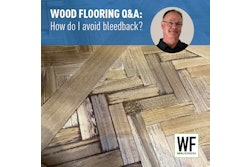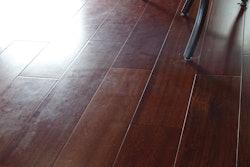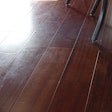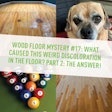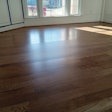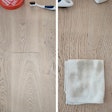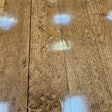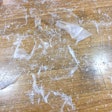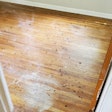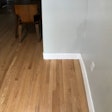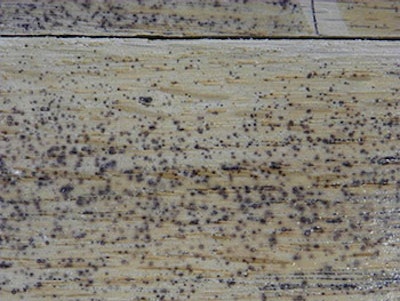
I recently came across a condition on a hardwood floor I had not seen in my 25-plus years as a consultant: a red oak floor littered with tiny black and gray spots. The homeowner told me the black spots appeared soon after the floor was resanded and had become increasingly worse. As I searched for more information on this problem, all I could find were vague references to metal shavings—common on hardwood floor projects due to contractors sharpening scrapers over the floor-causing black spots with waterborne finish, but nothing explained when, how or why this occurred.
The floor I was dealing with was 740 square feet of red oak flooring; its 38-year-old oil poly had been sanded off, and the red oak had been coated with waterborne urethane finish. The complaint included the presence of random yellow streaks of old finish and the black spots. The streaks were in locations where it was likely a metal file had been used.
If metal shavings were the issue on the floor I saw, my "educated" guess would be that the waterborne finish was corroding the particles; I had never seen this with oil-modified finishes. To confirm that metal particles could cause such black spots, I needed to research the effects of combined wood, chemicals, and metal. Following is what I learned.
Three things are needed to make ferric oxide (rust): iron, water (moisture) and oxygen. Common red-colored rust comes from hematite (a mineral form of iron (III) oxide, Fe2O3). Corrosion from a different iron (III) oxide, magnetite (Fe3O4), however, produces a black-colored rust. The flooring contractor told me he had used a metal file and a 1-inch wood scraper (high-carbon steel) when attempting to remove the old yellow finish streaks that hadn't come out with sanding. High-carbon steel in a low-oxygen environment combined with water, oxidants or acids (perhaps the finish?) creates rust. In lab tests, high-carbon steel is rated as one of the most susceptible to rust-black rust.
Wood is corrosive by nature, as it contains acetic acid (C2H4O2). Kiln drying accelerates the production of free acetic acid, making wood more immediately corrosive than when air dried. Species low in pH have higher corrosion levels. Oak has some of the lowest pH levels and is one of the most acidic and metal-corrosive wood species. The basic organic components of wood fiber are cellulose, hemicellulose and lignin, but wood may also contain volatile alcohols, esters and oils that, when combined with metal and corrosive chemicals (such as floor finish), can create an environment even more susceptible to corrosion.
Chemicals present in the floor coating process (water, formic and acetic acids, and others) can stimulate electrochemical cell activity, which also accelerates the rate of corrosion between metal and wood. Such chemicals can create lower oxygen levels, which also tend to create black rust. The chemical compounds found in waterborne flooring finishes can speed up the corrosion process more than just water. This might support the claim that the black spots were multiplying. We had acidic wood, metal particles susceptible to black corrosion, and corrosive chemicals. We needed to put them together and reproduce the black spots.
Upon testing, metal filings from the same brand of scraper blade were added to four wood floor finishes and applied to red oak. Normal living conditions were established: 68 degrees F at 32% relative humidity (RH).
Black spots did not develop, nor did they appear when the finish was applied to sealed red oak flooring. An oil poly finish was also tested as a control-no spots. Black spots did form, however, on a piece of red oak that was not part of the testing. Some waterborne floor finish had been accidentally spilled on a scrap piece of oak where the scraper had been sharpened, and these spots were exactly as seen in the claim floor! The difference appeared to be whether the metal shavings were worked into the open grain of freshly sanded wood. Wood fibers will conduct the flow of electrons much like wire; this electrical flow causes metals to break down and rust, thus explaining the importance of the metal actually coming into contact with raw wood fibers. When they were in contact and the waterborne finish was applied ... Kaboom! Spots! The wood itself was physically and chemically crucial to the corrosion process. Once we recreated this process, all four waterborne finishes rapidly created black rust spots.
Further tests showed that finish films made with finish and metal shavings showed no rust, yet when oak dust was added to the mix, the resulting film did contain black corrosion. Since displaying our results in our showroom for local contractors, we have had a few "witnesses" recall black spot issues. Most said they had recoated the floor with spots and moved on, with mixed results. Those who chose to recoat with oil-modified finishes said they had no further issues.
For the hardwood flooring industry, "Black Spots" seems to be the appropriate common name moving forward. For a more technical discussion, perhaps "MPCC" (Metallic Particle Corrosion Contamination) is appropriate? I am thoroughly pleased with our testing and hope this black spot mystery is solved. I am not pleased however, that my co-workers now call me "Spots!"
















